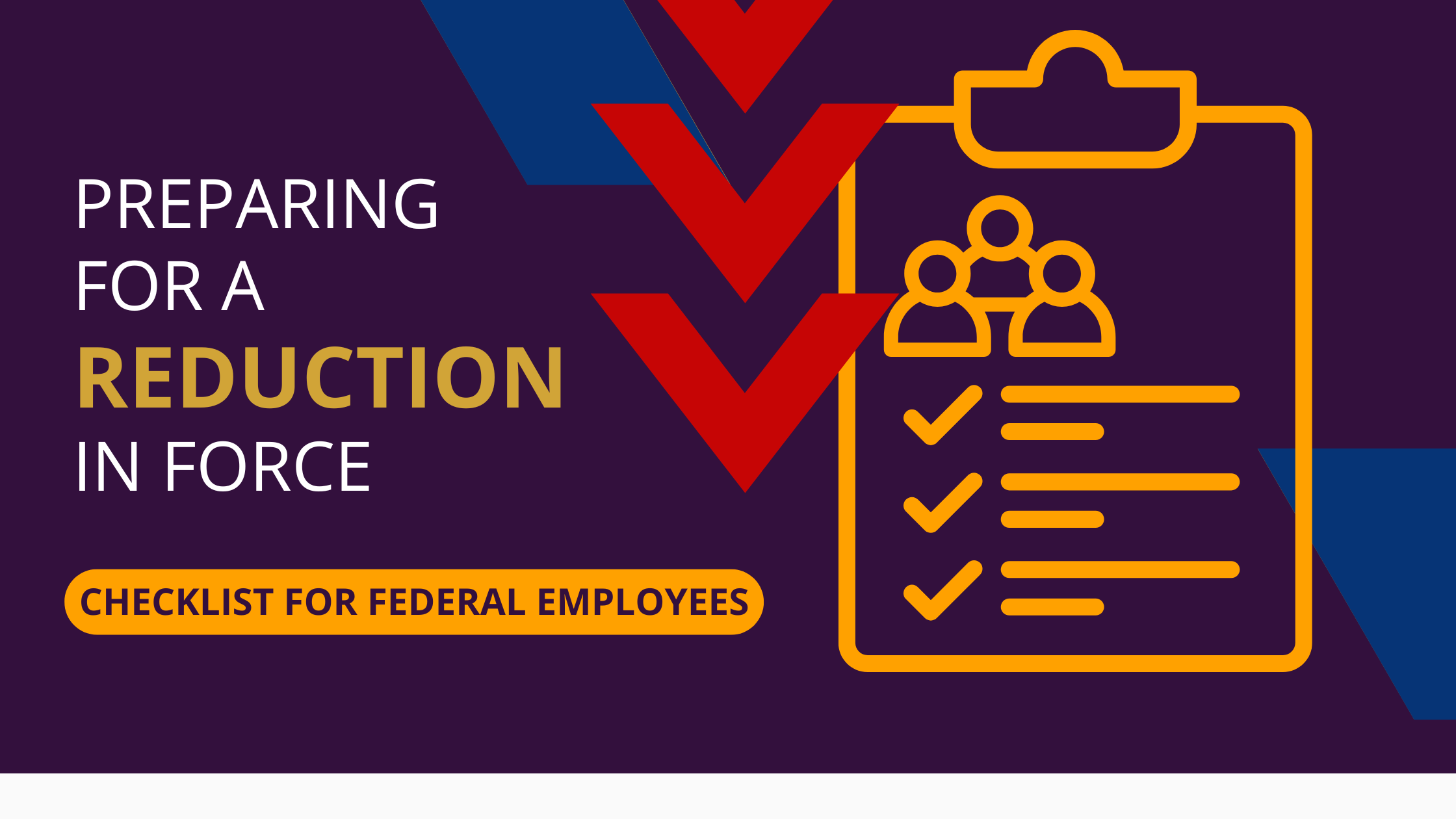Checklist for federal employees with agency possibly implementing a reduction in force (RIF). Learn what employment documents you need to prepare for mass layoff event.
Reduction in Force: Legal Requirements and Check List for Federal Employees
In the complex landscape of federal employment, understanding the intricacies of a Reduction in Force (RIF) is crucial for both employing agencies and employees. A RIF is a significant event that can lead to employment loss, affecting the livelihoods of many federal employees.
Learn about FERS, the TSP, FEHB, and more! Register for a free federal retirement online workshop.
Proactive Checklist for Federal Employees to Prepare for Reduction in Force (RIF)
Retrieve Important HR Documents from eOPF
While employees still have access to government HR systems, they should retrieve important documents from their eOPF (electronic Official Personnel Folder) related to employment, service credits, and retirement benefits. These include, but are not limited to:
- SF-50: Notification of Personnel Action – important document that records changes such as appointments, promotions, reassignments, separations, and other significant actions affecting an employee’s position or pay.
- Compensation Statement – provides information about salary and other pay, benefits such as retirement and health insurance, payroll deductions such as taxes, and total compensation figures.
- RIF Service Credit – information about tenure of federal service, veteran’s preference (if any), performance ratings, and what type for appointments were served during federal employment.
Confirm Mailing Address and Prepare for Loss of Access
If there is a sudden RIF and impacted employees’ access to government computer systems is terminated when the RIF notice is sent, then important correspondence with employees regarding severance pay, options retirement benefits, unemployment benefits, and possible reassignment opportunities would all be mailed to the address on file. Preparing for a sudden loss of access, including confirming the correct mailing address on file and gathering copies of personal documents, is a crucial step when proactively preparing for a possible RIF.
Reassignment Rights: Confirm Service Type and Review Possible Government Placement Programs
Investigating possible re-employment at a different federal agency or occupying a different position within the same agency will depend on a couple of factors, and may result in a separation or demotion by reduction. Most importantly, whether of not the federal employee’s terminated job was considered excepted or competitive service. Those hired and employed under excepted service have no appeal rights when facing an RIF unless those rights were explicitly given to an employee by their agency. For individuals leaving an excepted service position, but who also have veteran service, there might be government re-employment lists they’d be able to contribute their name to. Jobs considered competitive service undergo a different hiring process and have more rights to appeal the RIF decision. Once you have figured that out, you can start looking into government placement programs and the workforce restructuring and placement system process, including:
- Inter-Agency Career Transition Plan (ICTAP) – competitive service employees that vacated their job due to an RIF are eligible. The program determines the selection priority and objective criteria for reassignment and process for application. Grade and pay retention is not guaranteed when reemployed in the federal government, meaning your former rate of basic pay for each year could change.
- Reemployment Priority List (RPL) – helps eligible employees (for competitive service jobs removed when conducting a RIF, employees who received a certification of excepted separation, and employees who had previous left their position for at least one year due to a disability) find new positions in the federal government. Those on the RPL receive priority in the hiring process for applicable competitive service positions in commuting distance of the employee’s designated locality.
- Career Transition Assistance Plan (CTAP) – While ICTAP involves reemploying displaced federal workers with a different agency than their original employer, CTAP operates within the same agency, finding employment for those who lost their job due to an RIF.
- Workforce Innovation and Opportunity Act of 2014 Programs – For workers who recently separated from the federal government, these programs can help employees find new employment, provide training and preparation, and assist with career development.
Severance Payments and Unemployment Benefits
The last items on this checklist for federal employees to prepare for reduction in force (RIF) are:
- Locate Social Security Card – This might be required to receive unemployment benefits, so if you are unsure where yours is located, ordering a replacement now could prevent future delays in receiving pay from unemployment.
- Estimate Severance Pay – An agency can provide severance pay to employees who lost their employment due to an RIF. To calculate the amount of a future severance package, here is a worksheet from OPM.
While severance pay provides immediate financial support to employees affected by a RIF, it is distinct from unemployment benefits, which are administered by state agencies. Severance pay is typically a one-time payment, whereas unemployment benefits provide ongoing financial assistance to individuals who are actively seeking new employment. In some cases, if an employee meets certain eligibility standards, they may also want to explore FERS Discontinued Service Retirement.
Knowledge is Confidence!
What Legal Requirements Must Employers Follow During an RIF?
The legal basis for implementing a reduction in force is rooted in federal employment law and regulations. Employers must comply with the Code of Federal Regulations and other relevant statutes to ensure that the RIF is conducted lawfully. This includes adhering to policies that govern the selection of employees for separation, providing necessary notifications, and ensuring that the process is free from discrimination. Legal counsel is often sought to navigate the complexities of these requirements and to mitigate potential legal challenges as mandatory procedures and legal obligations must be adhered to.
Are RIF Notifications Required by Law?
Federal agencies are required to provide written notice to affected employees at least 60 days before the RIF takes effect. This advance notice is mandated by the Worker Adjustment and Retraining Notification (WARN) Act, which aims to give employees sufficient time to prepare for employment loss. The notification must include details about the RIF, the reasons for the reduction, and information about available resources for retraining and new employment opportunities.
How is Advance Notice Provided to Federal Employees?
Advance notice is provided to employees through written communication, as required by the WARN Act. This notice must be given at least 60 days before the RIF takes effect and should include detailed information about the reduction, the reasons behind it, and the impact on affected employees. Providing timely and clear communication is essential to help employees prepare for the changes and explore available options.
Addressing Discrimination Claims
Addressing potential discrimination claims is a critical consideration for employers during a RIF. Employers must ensure that their selection criteria and procedures are free from bias and comply with federal and state laws, including the Civil Rights Act of 1964. To protect themselves from discrimination claims during a RIF, employees must be aware of their rights under the Act of 1964 and other relevant anti-discrimination laws. Employees should document any instances of perceived discrimination and report them to the appropriate authorities within their agency. Seeking legal advice can also provide guidance on how to address potential discrimination issues and ensure that employees are treated fairly throughout the RIF process.
Federal Worker Adjustment and Retraining Notification Act
The Federal Worker Adjustment and Retraining Notification Act, commonly known as the WARN Act, plays a critical role in the RIF process. This legislation requires employers to provide advance notice to employees and local government officials when a mass layoff or RIF is planned. The purpose of the WARN Act is to give employees sufficient time to prepare for employment loss, seek new positions, or pursue retraining opportunities. Failure to comply with the federal WARN Act can result in significant penalties for employers, underscoring the importance of adherence to this legal requirement.
Seeking Legal Advice and Support
In the face of a RIF, an impacted employee may seek legal advice and support, which can provide guidance on the rights and protections available to them under federal law, as well as assist in addressing any potential legal issues that may arise during the RIF process. By consulting with experienced legal professionals, employees can ensure that their rights are upheld and that they receive the support they need during this challenging time.
For assistance with their financial plan and retirement savings, meet with a PlanWell advisor.
Reach Out to Us!
If you have additional federal benefit questions, contact our team of CERTIFIED FINANCIAL PLANNER™ (CFP®), Chartered Federal Employee Benefits Consultants (ChFEBC℠), and Accredited Investment Fiduciaries (AIF®). At PlanWell, we are federal employee financial advisors with a focus on retirement planning. Learn more about our process designed for the career fed.
Preparing for federal retirement? Check out our scheduled federal retirement workshops. Sign up for our no-cost federal retirement webinars in our workshop calendar. Make sure to plan ahead and reserve your seat for our FERS webinar, held every three weeks. Want to have PlanWell host a federal retirement seminar for your agency? Reach out, and we’ll collaborate with HR to arrange an on-site FERS seminar.
Want to fast-track your federal retirement plan? Skip the FERS webinar and start a one-on-one conversation with a ChFEBC today. You can schedule a one-on-one meeting through our Contact page.










